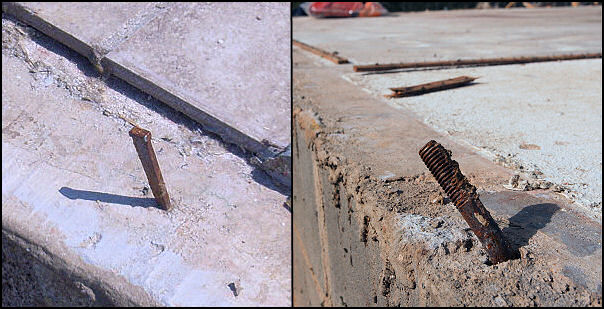 |
| About This Page |
| Arkansas has had its share of historic events, many of which will be in our memories for years to come. |
|
|
 |
No EF5 This Time: Anchor Bolts Not Detected in Most Construction |
 |
| |
|
Following the devastating tornado of April 27, 2014, it was noted (during damage surveys) that numerous homes were removed from their foundations with only slabs remaining. Years ago, that might be justification for an F5 rating on the original Fujita scale. These days, the quality of the construction is examined before a rating is assigned. One of the factors determining the rating is the use of anchor bolts.
Back in 2004, the Wind Science and Engineering Center at Texas Tech University submitted A Recommendation for an Enhanced Fujita Scale (EF-Scale) to the National Weather Service. The document went into great detail about wind speeds and resulting damage based on building standards and no "glaring weak links" in the construction. According to the document:
"A weak link is a discontinuity in the load path, which runs from the building surface through the structural system to the foundation. Inadequate nailing of wood roof decking, marginal anchoring of roof structure to top of wall, discontinuity in the connection between first and second floor, and use of cut nails instead of anchor bolts to attach sill plate to foundation are examples of load path discontinuities."
|
 |
| In the picture: This home to left in the Vilonia (Faulkner County) area had cut nails instead of anchor bolts to fasten the structure to the foundation. To the southwest of Roland (Pulaski County), another home to right had anchor bolts, but there were no signs of any washers or nuts to hold the walls in place. Both homes were wiped from their slabs by a tornado (rated EF4) on 04/27/2014. |
|
| |
|
In Vilonia (Faulkner County), for example, there was little indication of anchor bolts where homes once stood. At a subdivision to the southwest of town, the official survey results read as follows: "Houses completely destroyed; only slabs remaining at several places. No anchor bolts used in foundations."
|
| Not All Cut Nails |
|
To be fair, not every clean slab that was checked along the track of the tornado had cut nails. Several of these slabs had anchor bolts. However, there were signs that some of the bolts were improperly installed. At one home, for instance, there were no washers or nuts found on the bolts, and the bolts were not sheared off. In general, if survey crews found anchor bolts, and they were used as intended, the slabs were not clean.
|
|
Using cut nails to secure homes to the foundation is widely practiced and the minimum standard in most of the building codes. This is according to Dr. David Prevatt, Associate Professor of Civil and Coastal Engineering at the University of Florida. As stated by Dr. Prevatt:
"It is my opinion that cut nails can only be considered a temporary connection while installing a wall. They are in no way, shape or form have the capacity to resist the sliding loads or the uplift loads reduced by high winds that impact the walls of a building."
In theory, without anchor bolts, it took less wind to sweep houses away in Vilonia (Faulkner County). This was a big reason (but not the only explanation) for the EF4 (instead of EF5) rating that was ultimately decided upon. While the houses would have been destroyed even with anchor bolts, there is a chance that parts of the structures might have survived.
|
| An Expert Weighs In |
|
Well respected structural engineer, meteorologist and storm chaser Tim Marshall was in Arkansas in mid-May, 2014 to survey damage left in the wake of the tornado that ripped through Mayflower and Vilonia (both in Faulkner County). In the past, Mr. Marshall surveyed high end tornado damage in Jarrell, TX (May, 1997), Greensburg, KS (May, 2007), Joplin, MO (May, 2011) and Moore, OK (May, 2013). He also looked at the destruction following well-known hurricanes including Katrina (August, 2005). On May 16th, the National Weather Service in Little Rock (Pulaski County) was informed by Mr. Marshall that he agreed with the EF4 rating assigned to the local April 27th twister.
|
|
Anchor bolts could have made a difference where cut nails were discovered, but they did not make affected homes bulletproof. In Arkansas, the state residential building code calls for a design with anchor bolts every six feet in the foundation. Using this design, homes are supposed to withstand winds up to 90 mph (an EF1 tornado) without much difficulty. Beyond that, the load or shear force on each bolt is doubled at 127 mph (EF2 tornado), and tripled at 155 mph (EF3 tornado) according to Dr. Prevatt. He warns:
"Any and all buildings in Tornado Alley that are designed/constructed to the current building code (i.e. 90 mph) will fail," especially as tornadoes reach EF3/EF4 status.
Statistically, a tornado of this magnitude seldom occurs. Given this, and a fairly narrow path (usually less than a mile), the odds are remote that any one location is impacted by such a tornado. While the low risk will settle some stomachs, the absence of anchor bolts and inadequate building codes do not sit well with Dr. Prevatt:
"Bottom line - we either build them (our houses) stronger, or communities must accept that certain number of homes randomly selected by nature's wrath will be blown away and kill people in every moderately strong tornado for the foreseeable future."
|
|
|